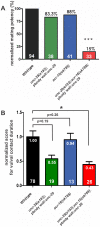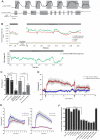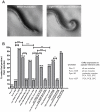A cholinergic-regulated circuit coordinates the maintenance and bi-stable states of a sensory-motor behavior during Caenorhabditis elegans male copulation
- PMID: 21423722
- PMCID: PMC3053324
- DOI: 10.1371/journal.pgen.1001326
A cholinergic-regulated circuit coordinates the maintenance and bi-stable states of a sensory-motor behavior during Caenorhabditis elegans male copulation
Abstract
Penetration of a male copulatory organ into a suitable mate is a conserved and necessary behavioral step for most terrestrial matings; however, the detailed molecular and cellular mechanisms for this distinct social interaction have not been elucidated in any animal. During mating, the Caenorhabditis elegans male cloaca is maintained over the hermaphrodite's vulva as he attempts to insert his copulatory spicules. Rhythmic spicule thrusts cease when insertion is sensed. Circuit components consisting of sensory/motor neurons and sex muscles for these steps have been previously identified, but it was unclear how their outputs are integrated to generate a coordinated behavior pattern. Here, we show that cholinergic signaling between the cloacal sensory/motor neurons and the posterior sex muscles sustains genital contact between the sexes. Simultaneously, via gap junctions, signaling from these muscles is transmitted to the spicule muscles, thus coupling repeated spicule thrusts with vulval contact. To transit from rhythmic to sustained muscle contraction during penetration, the SPC sensory-motor neurons integrate the signal of spicule's position in the vulva with inputs from the hook and cloacal sensilla. The UNC-103 K(+) channel maintains a high excitability threshold in the circuit, so that sustained spicule muscle contraction is not stimulated by fewer inputs. We demonstrate that coordination of sensory inputs and motor outputs used to initiate, maintain, self-monitor, and complete an innate behavior is accomplished via the coupling of a few circuit components.
Conflict of interest statement
The authors have declared that no competing interests exist.
Figures






Similar articles
-
DOP-2 D2-Like Receptor Regulates UNC-7 Innexins to Attenuate Recurrent Sensory Motor Neurons during C. elegans Copulation.J Neurosci. 2015 Jul 8;35(27):9990-10004. doi: 10.1523/JNEUROSCI.0940-15.2015. J Neurosci. 2015. PMID: 26156999 Free PMC article.
-
C. elegans dopaminergic D2-like receptors delimit recurrent cholinergic-mediated motor programs during a goal-oriented behavior.PLoS Genet. 2012;8(11):e1003015. doi: 10.1371/journal.pgen.1003015. Epub 2012 Nov 15. PLoS Genet. 2012. PMID: 23166505 Free PMC article.
-
Caenorhabditis elegans UNC-103 ERG-like potassium channel regulates contractile behaviors of sex muscles in males before and during mating.J Neurosci. 2003 Apr 1;23(7):2696-705. doi: 10.1523/JNEUROSCI.23-07-02696.2003. J Neurosci. 2003. PMID: 12684455 Free PMC article.
-
Regulation of sensory motor circuits used in C. elegans male intromission behavior.Semin Cell Dev Biol. 2014 Sep;33:42-9. doi: 10.1016/j.semcdb.2014.05.006. Epub 2014 Jun 2. Semin Cell Dev Biol. 2014. PMID: 24887696 Review.
-
C. elegans locomotion: small circuits, complex functions.Curr Opin Neurobiol. 2015 Aug;33:117-26. doi: 10.1016/j.conb.2015.03.009. Epub 2015 Apr 4. Curr Opin Neurobiol. 2015. PMID: 25845627 Review.
Cited by
-
Short-term nicotine exposure induces long-lasting modulation of gustatory plasticity in Caenorhabditis elegans.Biochem Biophys Rep. 2016 Aug 11;8:41-47. doi: 10.1016/j.bbrep.2016.08.008. eCollection 2016 Dec. Biochem Biophys Rep. 2016. PMID: 28955940 Free PMC article.
-
Six innexins contribute to electrical coupling of C. elegans body-wall muscle.PLoS One. 2013 Oct 9;8(10):e76877. doi: 10.1371/journal.pone.0076877. eCollection 2013. PLoS One. 2013. PMID: 24130800 Free PMC article.
-
PEZO-1 and TRP-4 mechanosensors are involved in mating behavior in Caenorhabditis elegans.PNAS Nexus. 2022 Sep 27;1(5):pgac213. doi: 10.1093/pnasnexus/pgac213. eCollection 2022 Nov. PNAS Nexus. 2022. PMID: 36712331 Free PMC article.
-
Sexual Dimorphism and Sex Differences in Caenorhabditis elegans Neuronal Development and Behavior.Genetics. 2018 Mar;208(3):909-935. doi: 10.1534/genetics.117.300294. Genetics. 2018. PMID: 29487147 Free PMC article.
-
Neurexin controls plasticity of a mature, sexually dimorphic neuron.Nature. 2018 Jan 10;553(7687):165-170. doi: 10.1038/nature25192. Nature. 2018. PMID: 29323291 Free PMC article.
References
-
- Emmons SW, Lipton J. Genetic basis of male sexual behavior. J Neurobiol. 2003;54:93–110. - PubMed
-
- Liu KS, Sternberg PW. Sensory regulation of male mating behavior in Caenorhabditis elegans. Neuron. 1995;14:79–89. - PubMed
-
- de Bono M, Maricq AV. Neuronal substrates of complex behaviors in C. elegans. Annu Rev Neurosci. 2005;28:451–501. - PubMed
-
- Gruninger TR, Gualberto DG, Garcia LR. Sensory perception of food and insulin-like signals influence seizure susceptibility. PLoS Genet. 2008;4:e1000117. doi: 10.1371/journal.pgen.1000117. - DOI - PMC - PubMed
Publication types
MeSH terms
Substances
Grants and funding
LinkOut - more resources
Full Text Sources
Research Materials
Miscellaneous

